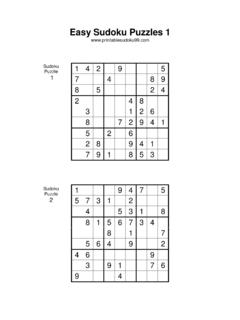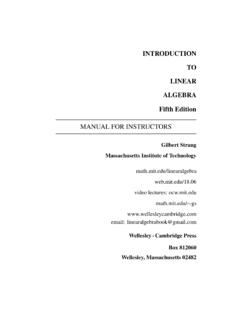Transcription of 20 Mathematical Problems suitable for Higher Tier GCSE ...
1 FMSP GCSE problem Solving Resources Further Mathematics Support Programme 20 mathematical problems suitable for higher Tier GCSE Students A collection of 20 Mathematical Problems to encourage the development of problem -solving skills at KS4. Each includes suggested questions to ask students to help them to think about the problem and a full worked solution. The problem sheets are available for free download separately from GCSE problem Solving booklet CM 12/08/15. Version 1. FMSP GCSE problem Solving Resources GCSE problem Solving booklet CM 12/08/15. Version 1. FMSP GCSE problem Solving Resources problem 1. Can you arrange the numbers 1 15 in a triangle where the number below each pair of numbers is the difference between those two numbers? Here's an example using the numbers 1 10: 6 1 10 8. 5 9 2. 4 7. 3. Can you complete the triangle below? 6 ? ? ? ? ? ? 12 ? ? ? 2. 4 ? 5. GCSE problem Solving booklet CM 12/08/15.
2 Version 1. FMSP GCSE problem Solving Resources Suggested Questions to ask students about problem 1. Note: It's important that students fully understand the term difference'. A difference between two numbers is never negative: it's just the distance between the numbers if you were to mark them on the number line. So the difference between 5 and 2 is 3, as is the difference between 2 and 5. Ask questions like What is the difference between 2 and 5?'. Then What is the difference between 5. and 2?'. If the difference between x and 5 is 2, what could x be? (there are two possibilities). If the difference between x and y is 10 what could x and y be?'. Now relate this to the triangle problem , if necessary asking questions like what could the missing numbers be in each of the following diagrams?'. ? 5 11 3 ? ? 10 ? 2. Getting into problem 1. Now look at the triangle in the problem . Ask if there are any numbers that can definitely be filled in straight away from the information given.
3 Once this is done, look at parts of the diagram where there is some information about the missing numbers but not enough to work them out exactly straight away. Ask what the possibilities are and lots of what if?' type questions. Remember that only the numbers from 1 15 inclusive can be used and that no number should appear twice. Keep asking question like what if this number is a 6?'. Like when doing a sudoku problem , it might be useful to make rough notes of which numbers could go where before committing to them. GCSE problem Solving booklet CM 12/08/15. Version 1. FMSP GCSE problem Solving Resources problem 1 Solution 1. Here is the initial grid 2. Some numbers can be entered from the bottom of the diagram, 9 then 11 then 1. These three are easy to see: 3. It's worth noting that the numbers in the 4. However the position marked 15 or 7. two positions highlighted below are not actually has to be 7 because 15 itself cannot immediately obvious based on the difference be a difference and so it needs to be in the property of the table alone.
4 There are two top row. 8 in the second row follows from possibilities for each of them, if you only this. consider that property. The position marked 14 or 10 has to be 10. because, of the available numbers, 14 can only be the difference between 15 and 1 but 1 is already used. 5. The remaining numbers to be put in are 3, 13, 14 and 15. With a bit of thought it's possible to see that this is the complete solution. GCSE problem Solving booklet CM 12/08/15. Version 1. FMSP GCSE problem Solving Resources problem 2. What number, when multiplied by itself, is equal to 27 x 147? GCSE problem Solving booklet CM 12/08/15. Version 1. FMSP GCSE problem Solving Resources Suggested Questions to ask students about problem 2. It's important that students realise they are looking for the square root of 27 x 147 in this question. It's worth asking, as an example to make this point, What is another name for the number, which when multiplied by itself, equals 57?
5 '. Ask students to approximate 27 x 147. Ask whether they can suggest some numbers whose square is this big? They may or may not be able to do this but it's a good thing for them to think about. The idea in this question is that there is a much better way to approach this. Ask students a good way to find the divisors of a number? Ask students the following here is a number expressed as a product of prime numbers, what is its square root?'. 3 x 3 x 3 x 3 x 5 x 5 x 11 x 11 x 17 x 17 x 17 x 17. Getting into problem 2. Remember that you don't have a calculator to do this. The first thing to think about is the phrase number, when multiplied by itself, gives . This means that you're looking for the square root of a certain number. Here that number is 27 x 147. If you actually do that multiplication by hand you'll get a pretty big number (about 4,000 or so) and it will be difficult to spot the square root.
6 Therefore you are looking for a better way to do this. This problem is about knowing divisors of 27 x 147 and picking out the one that is the square root. Finding prime factors is the best way to find out about all the divisors. An important realisation here is that the prime factors of 27 x 147 are the prime factors of 27 together with the prime factors of 147. When you write 27 x 147 as a product of prime factors you then need to think about how this tells you about its square root. GCSE problem Solving booklet CM 12/08/15. Version 1. FMSP GCSE problem Solving Resources problem 2 Solution 1. The number which, when multiplied by itself, is equal to 27 x 147 is the square root of 27 x 147. To get an idea of what this might be it's useful to investigate the prime factor of 27 x 147. These will be the prime factors of 27 together with the prime factors of 147. 27 x 147. 9 3 3 49. 3 3 7 7. 2.
7 So 27 x 147 = 3 x 3 x 3 x 3 x 7 x 7. Because there are an even number of 3s and an even number of 7s we can write this as a whole number squared: 27 x 147 = (3 x 3 x 7) x (3 x 3 x 7) = (3 x 3 x 7)2 = 632. 3. Think about why this would not have been possible if there had not been an even number of each prime factor. GCSE problem Solving booklet CM 12/08/15. Version 1. FMSP GCSE problem Solving Resources problem 3. If A is divided by B the result is 2/3. If B is divided by C the result is 4/7. What is the result if A is divided by C? GCSE problem Solving booklet CM 12/08/15. Version 1. FMSP GCSE problem Solving Resources Suggested Questions to ask students about problem 3. The key to this question is getting students to be able to write down a piece of information like if A is divided by B the answer is 2/3' as a Mathematical equation. Ask questions like If A is divided by B and the answer is 2/3 which is the bigger A or B?
8 Give me some examples of number A and B where if A is divided by B the answer is 2/3'. Can you write down an equation is satisfied by A and B if A divided by B is 2/3?'. To get students thinking about A divided by C you could ask questions like If A is twice as big as B as B is four times as big as C how many times bigger is A than C'? Getting into problem 3. Think about what if A is divided by B the answer is 2/3' tells you about A and B? There are lots of different ways to write this. One is A 2. B 3. another is that the ratio A : B is 2 : 3. You could even rearrange the above to get 3A = 2B. Now think about what you need to do. You have a statement about A and B and another statement about B and C but you want to end up with a statement about A. and C. Somehow you need to combine the two pieces of information so that B is no longer involved. What does this remind you of? Sometimes when you are dealing with more than one equation you try to eliminate some of the letters.
9 GCSE problem Solving booklet CM 12/08/15. Version 1. FMSP GCSE problem Solving Resources problem 3 Solution 1. First of all write down what you know. This is that A 2 B 4. and that B 3 C 7. 2. The key thing to realise in this question is that A B A. B C C. This is just the usual cancellation law when you multiply fractions. 3. This means that A A B 2 4. C B C 3 7 21. GCSE problem Solving booklet CM 12/08/15. Version 1. FMSP GCSE problem Solving Resources problem 4. Each shape contained within the largest square is also a square. The number in each square gives the length of its sides. What are the values of A, B, C and D? 10 10. 15. C. B 12. 4. 12 A. D. 13. 4. 8 10. 4. GCSE problem Solving booklet CM 12/08/15. Version 1. FMSP GCSE problem Solving Resources Suggested Questions to ask students about problem 4. What is the length of the sides of the big square? So how long is any horizontal line going from side to side or vertical line going from top to bottom of the big square?
10 (This is a slightly strange question which possibly overcomplicates a rather trivial point so you might not want to use this.). Write down the equations you get using this fact for some randomly selected horizontal or vertical lines? Are some of the equations easier than others? Getting into problem 4. Look at the diagram, think about what you are trying to work out and what information you can get from the diagram. You should be able to work out how long the sides of the big square are. Now remember that any horizontal line going from side to side or vertical line going from top to bottom of the big square will have that length. Such horizontal or vertical lines will give you different equations involving A, B, C and D. Can you find any equations this way that just involve one of these letters? GCSE problem Solving booklet CM 12/08/15. Version 1. FMSP GCSE problem Solving Resources problem 4 Solution D.



